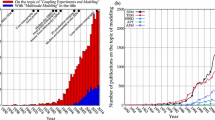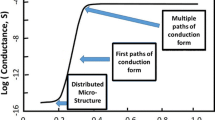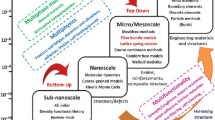Abstract
What do nanoscopic biomolecular complexes between the cells that line our blood vessels have in common with the microscopic silicate glass fiber optics that line our communication highways, or with the macroscopic steel rails that line our bridges? To be sure, these are diverse materials which have been developed and studied for years by distinct experimental and computational research communities. However, the macroscopic functional properties of each of these structurally complex materials pivots on a strong yet poorly understood interplay between applied mechanical states and local chemical reaction kinetics. As is the case for many multiscale material phenomena, this chemomechanical coupling can be abstracted through computational modeling and simulation to identify key unit processes of mechanically altered chemical reactions. In the modeling community, challenges in predicting the kinetics of such structurally complex materials are often attributed to the so-called rough energy landscape, though rigorous connection between this simple picture and observable properties is possible for only the simplest of structures and transition states. By recognizing the common effects of mechanical force on rare atomistic events ranging from molecular unbinding to hydrolytic atomic bond rupture, we can develop perspectives and tools to address the challenges of predicting macroscopic kinetic consequences in complex materials characterized by rough energy landscapes. Here, we discuss the effects of mechanical force on chemical reactivity for specific complex materials of interest, and indicate how such validated computational analysis can enable predictive design of complex materials in reactive environments.
Similar content being viewed by others
References
Walton E.B., Lee S., Vliet K.J.: Extending Bell’s model: how force transducer stiffness alters measured unbinding forces and kinetics of molecular complexes. Biophys. J. 94, 2621–2630 (2007)
Silva E.C., Tong L., Yip S., Vliet K.J.: Size effects on the stiffness of silica nanowires. Small 2(2), 239–243 (2006)
Forst, C.J., Slycke, J., Van Vliet, K.J., Yip, S.: Point defect concentrations in metastable Fe–C alloys. Phys. Rev. Lett. 96(17) (2006)
Andrews B.T., Schoenfish A.R., Roy M., Waldo G., Jennings P.A.: The rough energy landscape of superfolder GFP is linked to the chromophore. J. Mol. Biol. 373(2), 476–490 (2007)
Gruebele M.: Rough energy landscape of folded and unfolded proteins. Abstr. Pap. Am. Chem. Soc. 227, U267–U267 (2004)
Wang J., Huang W.M., Lu H.Y., Wang E.K.: Downhill kinetics of biomolecular interface binding: Globally connected scenario. Biophys. J. 87(4), 2187–2194 (2004)
Onuchic J.N., Wolynes P.G.: Energy landscapes, glass transitions, and chemical-reaction dynamics in biomolecular or solvent environment. J. Chem. Phys. 98(3), 2218–2224 (1993)
Simka H., Willis B.G., Lengyel I., Jensen K.F.: chemistry predictions of reaction processes in organometallic vapor phase epitaxy. Progress in Crystal Growth and Characterization of Materials 35(2–4), 117–149 (1997)
Wesolowski T., Muller R.P., Warshel A.: Ab initio frozen density functional calculations of proton transfer reactions in solution. J. Phys. Chem. 100(38), 15444–15449 (1996)
Kim K., Jordan K.D.: Comparison of density-functional and Mp2 calculations on the water monomer and dimer. J. Phys. Chem. 98(40), 10089–10094 (1994)
Henkelman G., Uberuaga B.P., Jonsson H.: A climbing image nudged elastic band method for finding saddle points and minimum energy paths. J. Chem. Phys. 113(22), 9901–9904 (2000)
Henkelman G., Jonsson H.: Improved tangent estimate in the nudged elastic band method for finding minimum energy paths and saddle points. J. Chem. Phys. 113(22), 9978–9985 (2000)
Sorensen M.R., Brandbyge M., Jacobsen K.W.: Mechanical deformation of atomic-scale metallic contacts: Structure and mechanisms. Phys. Rev. B 57(6), 3283–3294 (1998)
Pincet F., Husson J.: The solution to the streptavidin-biotin paradox: the influence of history on the strength of single molecular bonds. Biophys. J. 89, 4374–4381 (2005)
Merkel R., Nassoy P., Leung A., Ritchie K., Evans E.: Energy landscapes of receptor–ligand bonds explored with dynamic force spectroscopy. Nature 397, 50–53 (1999)
Coureux P.-D., Fan X., Sojanoff V., Genick U.K.: Picometer-scale conformational heterogeneity separates functional from nonfunctional states of a photoreceptor protein. Structure 16, 863–872 (2008)
Kellou, A., Grosdidier, T., Aourag, H.: An ab initio study of the effects and stability of vacancies, antisites and small radius atoms (B, C, N, and O) in the B2–FeAl structure. In: Fisher, D.J. (ed.) Defects and Diffusion in Metals—An Annual Retrospective VII, vol. 233–234, pp. 87–95. Defect and Diffusion Forum (2004)
Lau T.T., Foerst C.J., Lin X., Gale J.D., Yip S., Van Vliet K.J.: Many-body potential for point defect clusters in Fe–C alloys. Phys. Rev. Lett. 98(21), 215501 (2007)
Legris, A.: Recent advances in point defect studies driven by density functional theory. In: Fisher, D.J. (ed.) Defects and Diffusion in Metals—An Annual Retrospective VII, vol. 233–234, pp. 77–86. Defect and Diffusion Forum (2004)
Mizuno T., Asato M., Hoshino T., Kawakami K.: First-principles calculations for vacancy formation energies in Ni and Fe: non-local effect beyond the LSDA and magnetism. J. Magn. Magn. Mater. 226, 386–387 (2001)
Simonetti S., Pronsato M.E., Brizuela G., Juan A.: The C–C pair in the vicinity of a bcc Fe bulk vacancy: electronic structure and bonding. Phys. Status Solidi B Basic Solid State Phys. 244(2), 610–618 (2007)
Becquart C.S., Souidi A., Domain C., Hou M., Malerba L., Stoller R.E.: Effect of displacement cascade structure and defect mobility on the growth of point defect clusters under irradiation. J. Nucl. Mater. 351(1–3), 39–46 (2006)
Domain C.: Ab initio modelling of defect properties with substitutional and interstitials elements in steels and Zr alloys. J. Nucl. Mater. 351(1–3), 1–19 (2006)
Cao C., He Y., Torras J., Deumens E., Trickey S.B., Cheng H.P.: Fracture, water dissociation, and proton conduction in SiO2 nanochains. J. Chem. Phys. 126(21), 211101 (2007)
Zhu T., Li J., Yip S., Bartlett R.J., Trickey S.B., Leeuw N.H.: Deformation and fracture of a SiO2 nanorod. Mol. simul. 29(10–11), 671–676 (2003)
McConnell J.D.C.: Ab initio studies on water related species in quartz and their role in weakening under stress. Phase Transit. 61(1–4), 19–39 (1997)
Silva, E., Van Vliet, K.J., Yip, S.: Effects of water on chemomechanical instabilities in amorphous silica: nanoscale experiments and molecular simulation. PhD Thesis, Silva, MIT, unpublished results (2007)
Van Vliet, K.J., Li, J., Zhu, T., Yip, S., Suresh, S.: Quantifying the early stages of plasticity through nanoscale experiments and simulations. Phys. Rev. B 67(10)(2003)
Li J., Zhu T., Yip S., Vliet K.J., Suresh S.: Elastic criterion for dislocation nucleation. Mater. Sci. Eng. A Struct. Mater. Prop. Microstruct. Process. 365(1–2), 25–30 (2004)
Li J., Vliet K.J., Zhu T., Yip S., Suresh S.: Atomistic mechanisms governing elastic limit and incipient plasticity in crystals. Nature 418(6895), 307–310 (2002)
Coureux P.-D., Fan Z., Stojanoff V., Genick U.K.: Picometer-scale conformational heterogeneity separates functional and nonfunctional states of a photoreceptor protein. Structure 6, 863–872 (2008)
Puklin-Faucher E., Gao M., Schulten K., Vogel V.: How the headpiece hinge angle is opened: new insights into the dynamics of integrin activation. J. Cell Biol. 175(2), 349–360 (2006)
Wriggers W., Mehler E., Pitici F., Weinstein H., Schulten K.: Structure and dynamics of calmodulin in solution. Biophys. J. 74(4), 1622–1639 (1998)
Sheng Q., Schulten K., Pidgeon C.: Molecular-dynamics simulation of immobilized artificial membranes. J. Phys. Chem. 99(27), 11018–11027 (1995)
Evans E., Ritchie K.: Dynamic strength of molecular adhesion bonds. Biophys. J. 72(4), 1541–1555 (1997)
Merkel R., Nassoy P., Leung A., Ritchie K., Evans E.: Energy landscapes of receptor–ligand bonds explored with dynamic force spectroscopy. Nature 397(6714), 50–53 (1999)
Lee S., Mandic J., Vliet K.J.: Chemomechanical mapping of ligand–receptor binding kinetics on cells. Proc. Natl. Acad. Sci. USA 104(23), 9609–9614 (2007)
Hinterdorfer P., Baumgartner W., Gruber H.J., Schilcher K., Schindler H.: Detection and localization of individual antibody-antigen recognition events by atomic force microscopy. Proc. Natl. Acad. Sci. USA 93(8), 3477–3481 (1996)
Stroh C.M., Ebner A., Geretschlager M., Freudenthaler G., Kienberger F., Kamruzzahan A.S.M., Smith-Gil S.J., Gruber H.J., Hinterdorfer P.: Simultaneous topography and recognition Imaging using force microscopy. Biophys. J. 87(3), 1981–1990 (2004)
Vliet K.J., Hinterdorfer P.: Probing drug–cell interactions. Nano Today 1(3), 18–25 (2006)
Walton E.B., Van Vliet K.J.: Equilibration of experimentally determined protein structures for molecular dynamics simulation. Phys. Rev. E 74(6), 061901 (2006)
Evans E.: Looking inside molecular bonds at biological interfaces with dynamic force spectroscopy. Biophys. Chem. 82, 83–87 (1999)
McCammon J.A., Gelin B.R., Karplus M.: Dynamics offolded proteins. Nature 267, 585–590 (1977)
McCammon J.A., Karplus M.: Simulation of protein dynamics. Annu. Rev. Phys. Chem. 31, 29–45 (1980)
Craig D., Gao M., Schulten K., Vogel V.: Structural insights into how the MIDAS ion stabilizes integrin binding to an RGD peptide under force. Structure 12(11), 2049–2058 (2004)
Isralewitz B., Izrailev S., Schulten K.: Binding pathway of retinal to bacterio-opsin: a prediction by molecular dynamics simulations. Biophys. J. 73(6), 2972–2979 (1997)
Kosztin D., Izrailev S., Schulten K.: Unbinding of retinoic acid from its receptor studied by steered molecular dynamics. Biophys. J. 76(1), 188–197 (1999)
Curcio R., Caflisch A., Paci E.: Change of the unbinding mechanism upon a mutation: a molecular dynamics study of an antibody–hapten complex. Protein Sci. 14(10), 2499–2514 (2005)
Paci E., Caflisch A., Pluckthun A., Karplus M.: Forces and energetics of hapten-antibody dissociation: a biased molecular dynamics simulation study. J. Mol. Biol. 314(3), 589–605 (2001)
Krishnan, R., Walton, E.B., Van Vliet, K.J.: in review (2008)
Mendenhall, W., Beaver, R.J., Beaver, B.M.: Introduction to Probability and Statistics. 12th ed., Thomson Higher Education, Belmont, CA (2006)
Chaturvedi S., Ocxhendorf J.: Global environmental impacts due to concrete and steel. Struct. Eng. Int. 14(3), 198–200 (2004)
Ulm F.J., Constantinides G., Heukamp F.H.: Is concrete a poromechanics material?—a multiscale investigation of poroelastic properties. Mater. Struct. 37(265), 43–58 (2004)
Jennings H.M., Thomas J.J., Gevrenov J.S., Constantinides G., Ulm F.J.: A multi-technique investigation of the nanoporosity of cement paste. Cem. Concr. Res. 37(3), 329–336 (2007)
Constantinides G., Ulm F.J.: The effect of two types of C-S-H on the elasticity of cement-based materials: Results from nanoindentation and micromechanical modeling. Cem. Concr. Res. 34(1), 67–80 (2004)
Author information
Authors and Affiliations
Corresponding author
Rights and permissions
About this article
Cite this article
Van Vliet, K.J. Chemomechanics of complex materials: challenges and opportunities in predictive kinetic timescales. Sci Model Simul 15, 67–80 (2008). https://doi.org/10.1007/s10820-008-9111-3
Received:
Accepted:
Published:
Issue Date:
DOI: https://doi.org/10.1007/s10820-008-9111-3




